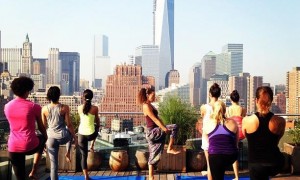A year and a half ago, I moved halfway around the world to the Pacific Northwest from my hometown in South India. I left home with bittersweet feelings — I was excited for the new possibilities, but at the same time, sad to leave everything familiar and dear back home. It was a big, tumultuous move and the one thing that remained constant for me was yoga. It was my friend when I had none, it gave me a sense of purpose when I woke up each morning. For several months, I struggled with the challenges of settling in a new country — I did not know how to drive, had to get used to a winter unlike any I had experienced, find a house, furnish the house, find a job and get my life in order. It was not easy and I was often very lonely and bitter about having left so much behind. But being someone who has always been driven, I woke up and pursued yoga every day. I’d go to yoga classes nearby, and try to make friends with students. I read up about the local yoga events and community. Yoga became my best friend all over again and kept me sane and happy. It made me feel like I was home.
Initially, I had no idea what the yoga scene would be like in Seattle and in the U.S. Every day I learned something new. There is so much yoga around here, that it was and continues to be exciting for a yoga geek like me. America is a nation that seems to have an excess of everything, and yoga is no exception. I couldn’t help but be fascinated by the differences between yoga in the U.S. and in India and these are a few of my observations.
Observation #1: yoga in America is more popular among the masses than yoga in India
Yoga is a craze here. Almost everyone seems to do it. Yoga is practiced back home, but it is available far more easily and commercially available here. The west has successfully commercialized yoga and there’s an amazing range and variety. Back home, people practice yoga as a way for spiritual growth and pursue other practices like going to the gym or aerobics for health reasons. When I looked at class schedules here, I was often surprised and shocked at the variety that was offered. I knew of different styles and lineages, but the idea of chocolate yoga, yoga to live music, rock-and-roll yoga, naked yoga, love yoga, etc. would shock the daylights out of me. Coming from a traditional yoga background, I often found myself annoyed and upset, but soon learned to ignore the eccentric ideas that have borrowed the name of yoga.
Observation #2: the yoga teacher-student dynamic in India is drastically different than in the US
I have met some great teachers here. But I must say that the teaching styles vary dramatically. In India, the ancient concept of Guru-shishya parampara (teacher-disciple traditions) is a strong part of the culture, both in and outside of yoga. The teacher is revered and respected and his or her word is absolute. A teacher draws you from ignorance to light. A student doesn’t behave casually or talk back in the presence of the teacher. A student serves the teacher out of respect and gratitude. There is a certain way to sit, talk and interact with someone respected or elder to us. In classes I attended here, I’ve seen a far more casual dynamic. Students interact informally with the teacher, some never acknowledge the teacher, some do their own sequence in a group class and some even talk back to the teacher. It’s taken me some time to get used to!
Observation #3: the teaching styles vary greatly between India and America
In India we believe that teaching is the noblest profession. When someone passes their knowledge to you, it is an honor. I have been privileged enough to study under some great masters. Even though the language of instruction is English in both places, there is a big difference in how yoga teachers instruct a class here and back home. Most Indian teachers’ instructions are limited to the alignment, breathing patterns, focus of the mind, and other guidelines around the asana and its benefits. The language used is plain and simple. Here, I’ve noticed how the yoga language is different for many teachers. Some spoke about healing, relationships, heart opening, pain, sorrow, joy, trauma etc. in class. This was alien to me. It would be considered an unnecessary distraction back home. I do appreciate though that different things work for different people. Like the Bhagavad Gita says, “there are as many yogas as there are people”.
Observation #4: the combination of yoga & fashion in the US is not present in India
I did not know of special yoga clothing until I moved here. For me dressing for class meant a comfortable track pant and a breathable t-shirt. While I have been excited to have access to the variety offered here, it is a astonishing that there are multi-million dollar businesses using yoga as a vehicle to sell products to people. In India, people show up in very casual comfortable everyday clothes for a class. They do not spend a lot of money accessorizing themselves to look good in class. After all, yoga is about detaching from the body and senses. You will often spot women doing yoga in their traditional outfits like sarees and lifting themselves up in a graceful headstand. Yoga is a part of everyday life for those who practice it.
Observation #5: the popularity of hot yoga in the US contrasts with its rarity in India
Hot yoga is almost unheard of in India: Yes, it’s true! While hot yoga is very popular here, it is not well known in India. In fact, most yoga practitioners have no idea who Bikram is or what hot yoga is! I heard of hot yoga much later in my teacher training when someone mentioned heating up the room. There are probably a couple of studios now that offer hot yoga back home, although we don’t need it with our hot climate. Traditional Indian teachers do not recognize this as a form of yoga and caution that this is not how yoga was meant to be practiced.
Even though there are differences, yoga unites people all over the world. We may be different on the surface but we all seek the same goals of good health and liberation. The paths we take towards yoga are many, but in the end they all unite. No path is higher or inferior than another. What I have learned from moving across the globe is that yoga is universal and I’ve been inspired to see how people around the world have embraced yoga and evolved with it. It is a key to freedom that belongs to all humanity.
Article originally posted on SeattleYogaNews.com
Image by © Luca Tettoni/Corbis









No Comments